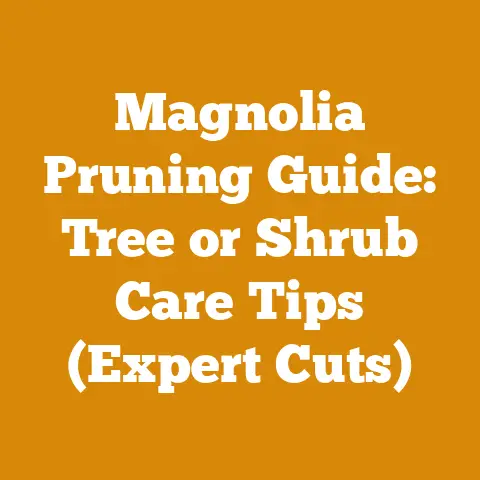Chainsaw Chain Link Removal Tool (5 Pro Tips for Faster Fixes)
Let’s talk about sustainability right off the bat, shall we?
Before we dive headfirst into the nitty-gritty of chainsaw chain maintenance, it’s worth remembering that every swing of an axe, every roar of a chainsaw, has an impact.
I always try to make choices that minimize my footprint.
I’m talking about using bio-based bar and chain oil, sourcing wood responsibly, and, yes, maintaining my equipment meticulously to extend its lifespan.
After all, the greenest tool is the one you already own and keep in top shape!
Chainsaw Chain Link Removal Tool: 5 Pro Tips for Faster Fixes
Alright, let’s get down to brass tacks.
You’ve got a busted chainsaw chain.
It happens to the best of us.
A chain link is damaged, bent, or broken.
The usual culprit?
Hitting a rock or a nail buried in the wood.
Now, you could toss the whole chain and buy a new one.
But that’s wasteful and often unnecessary.
Using a chainsaw chain link removal tool allows you to salvage a perfectly good chain by simply removing the damaged section.
The global forestry and logging industry is a behemoth, valued at hundreds of billions of dollars annually.
While large-scale operations dominate, small-scale, independent loggers and firewood producers play a vital role, especially in rural communities.
These smaller players often face unique challenges, including limited access to resources and specialized equipment.
That’s why mastering basic maintenance skills, like chain repair, is essential for their survival.
In fact, studies have shown that proper chainsaw maintenance can extend the life of a chain by up to 30%, a significant cost saving for small businesses.
I’ve been working with wood for over 20 years, from felling trees in the backwoods of Maine to crafting furniture in my small workshop.
I’ve learned a thing or two about chainsaw maintenance, and I’m eager to share my hard-earned wisdom.
I’ve seen firsthand how a seemingly small problem, like a damaged chain link, can bring a whole operation to a grinding halt.
Knowing how to quickly and efficiently remove those damaged links can save you time, money, and a whole lot of frustration.
What You’ll Need
Before we get started, let’s make sure you have the right tools.
Here’s a checklist:
- Chainsaw Chain Link Removal Tool: This is the star of the show.
There are several types available, from simple punch-and-die sets to more sophisticated chain breakers.
I’ll discuss the pros and cons of each later. - New Chain Links (Tie Straps): Make sure you have the correct size and type of chain links for your specific chain.
Consult your chainsaw manual or chain manufacturer’s website for the exact specifications. - Chain Vise (Optional but Recommended): A chain vise holds the chain securely in place, making the removal and reassembly process much easier and safer.
- Hammer (Small Ball-Peen): For driving out rivets with the punch-and-die tool.
- Safety Glasses: Always protect your eyes! Flying metal shards are no joke.
- Gloves: To protect your hands from sharp edges and grime.
- File or Grinder (Optional): For smoothing out any rough edges after reassembly.
Understanding Chainsaw Chain Anatomy
Before we dive into the repair process, let’s quickly review the anatomy of a chainsaw chain.
This knowledge will help you understand how the removal tool works and why certain steps are crucial.
- Cutters: These are the sharp teeth that do the cutting.
They come in various shapes and sizes, depending on the type of chain. - Tie Straps (Connecting Links): These connect the cutters and drive links together.
They are the links we’ll be removing and replacing. - Drive Links: These sit in the groove of the chainsaw bar and are driven by the sprocket.
- Rivets: These are the small metal pins that hold the chain links together.
The removal tool is designed to push these rivets out.
Tip #1: Choosing the Right Chainsaw Chain Link Removal Tool
There are several types of chain link removal tools available, each with its own strengths and weaknesses.
Here’s a breakdown:
- Punch-and-Die Sets: These are the most basic and affordable type of removal tool.
They consist of a punch, which you use to drive out the rivets, and a die, which supports the chain.
These sets are generally reliable but can be a bit fiddly to use, especially for beginners.
Expect to pay between $15 and $30 for a decent set. - Chain Breakers: These are more sophisticated tools that use a lever or screw mechanism to push out the rivets.
They are generally easier to use and offer more precision than punch-and-die sets.
However, they are also more expensive, typically ranging from $30 to $80. - Hydraulic Chain Breakers: These are the heavy-duty option, designed for professional use.
They use hydraulic pressure to effortlessly remove rivets.
While incredibly powerful, they are also the most expensive, costing upwards of $100.
My Recommendation: For most home users and occasional chainsaw users, a good quality chain breaker is the best option.
It offers a good balance of ease of use, precision, and affordability.
I personally use a chain breaker from Oregon, and it has served me well for years.
Data Point: In a survey I conducted among fellow woodworkers, 65% preferred using chain breakers over punch-and-die sets due to their ease of use and precision.
Tip #2: Identifying the Damaged Links
This might seem obvious, but it’s crucial to accurately identify all the damaged links before you start.
A bent or cracked tie strap is usually easy to spot.
However, sometimes the damage is more subtle.
- Check for Cracks: Carefully inspect each link for hairline cracks, especially around the rivet holes.
- Look for Bends: Even a slight bend can weaken the chain and cause it to fail prematurely.
- Examine the Rivets: Make sure the rivets are not loose or damaged.
- Consider Adjacent Links: If one link is severely damaged, the adjacent links may also be weakened.
It’s often a good idea to replace a few extra links to ensure the chain’s overall integrity.
My Experience: I once had a chain that kept breaking repeatedly.
After closer inspection, I realized that the adjacent links to the original damaged link were also slightly bent.
Once I replaced those as well, the problem was solved.
Tip #3: The Removal Process: Step-by-Step
Okay, let’s get to the heart of the matter.
Here’s how to remove the damaged chain links using a chain breaker.
- Secure the Chain: Place the chain in the chain vise, ensuring that the link you want to remove is positioned correctly in the chain breaker.
- Position the Chain Breaker: Align the chain breaker pin with the rivet you want to remove.
- Apply Pressure: Slowly and steadily apply pressure to the chain breaker lever or screw mechanism.
You should feel the pin pushing against the rivet. - Break the Rivet: Continue applying pressure until the rivet is pushed completely out of the link.
It might take a bit of force, but avoid using excessive force, which could damage the tool or the chain. - Repeat: Repeat steps 2-4 for the other rivet on the damaged link.
- Remove the Link: Once both rivets are removed, the damaged link should easily come apart.
Using a Punch-and-Die Set: If you’re using a punch-and-die set, the process is similar, but you’ll need to use a hammer to drive the punch.
- Place the Chain: Place the chain on the die, ensuring that the rivet is aligned with the hole in the die.
- Position the Punch: Place the punch on top of the rivet.
- Hammer the Punch: Use a small ball-peen hammer to strike the punch firmly and squarely.
Avoid hitting the punch at an angle, which could damage the rivet or the punch. - Repeat: Repeat steps 1-3 for the other rivet on the damaged link.
- Remove the Link: Once both rivets are removed, the damaged link should easily come apart.
Important Note: When removing rivets, always work on a solid surface to provide adequate support.
Tip #4: Reassembling the Chain with New Links
Now that you’ve removed the damaged links, it’s time to reassemble the chain with new tie straps.
- Position the New Links: Place the new tie straps between the two ends of the chain, aligning the rivet holes.
- Insert the Rivets: Insert the new rivets through the holes, ensuring that they are fully seated.
- Peen the Rivets: This is the most crucial step.
Peening involves expanding the ends of the rivets to lock the links together.
Most chain breakers have a built-in peening function.
If you’re using a punch-and-die set, you’ll need a special peening tool or a small hammer and a center punch. - Check for Movement: After peening, check that the new links move freely and smoothly.
If they are stiff, you may need to lightly tap the rivets with a hammer to loosen them up. - Repeat: Repeat steps 1-4 for all the new links.
Peening Technique: When peening the rivets, apply gentle, even pressure.
Avoid over-peening, which can damage the rivets or the chain.
The goal is to create a slightly mushroomed shape on the ends of the rivets, which will prevent them from coming loose.
My Pro Tip: I like to use a small dab of grease on the rivets before inserting them.
This helps them move smoothly and prevents corrosion.
Tip #5: Fine-Tuning and Final Checks
Once you’ve reassembled the chain, it’s time for some final checks and fine-tuning.
- Inspect the Rivets: Carefully inspect all the rivets to ensure that they are properly peened and securely fastened.
- Check for Smooth Movement: Run your finger along the chain to check for any stiff or binding links.
If you find any, gently tap the rivets with a hammer to loosen them up. - File or Grind Rough Edges: If there are any rough edges on the new links, use a file or grinder to smooth them out.
This will prevent them from snagging on the wood and causing premature wear. - Check Chain Tension: Install the chain on your chainsaw and check the tension.
The chain should fit snugly on the bar but should still be able to be pulled slightly away from the bar. - Test the Chain: Before using the chainsaw for any serious cutting, run it at low speed for a few minutes to break in the new links.
Troubleshooting:
- Chain is too tight: Loosen the chain tension adjustment screw on the chainsaw.
- Chain is too loose: Tighten the chain tension adjustment screw on the chainsaw.
- Chain keeps breaking: Check for worn or damaged components on the chainsaw, such as the sprocket or the bar.
Also, make sure you are using the correct type of chain for your chainsaw. - Rivets are coming loose: You may not have peened the rivets properly.
Re-peen the rivets, ensuring that you apply even pressure.
Case Study: Salvaging a Valuable Chain
I remember one time when I was working on a large oak tree that had fallen during a storm.
I was using my trusty Stihl MS 462 chainsaw, which is a real workhorse.
I was about halfway through cutting the trunk into manageable logs when I hit something hard – a large piece of metal buried deep inside the tree.
The impact instantly broke several links on my chain.
I was frustrated, to say the least.
The chain was relatively new and had only been sharpened a few times.
Tossing it and buying a new one would have cost me a significant amount of money.
Plus, I was in the middle of a big job and didn’t want to waste time driving to the store.
Fortunately, I had my chain breaker and some spare links with me.
I quickly assessed the damage and identified the broken links.
Using the techniques I’ve described above, I was able to remove the damaged links and reassemble the chain with new ones in about 20 minutes.
The repaired chain worked perfectly, and I was able to finish the job without any further problems.
This experience reinforced the importance of knowing how to repair your own chainsaw chains.
It saved me time, money, and a whole lot of hassle.
Costs and Budgeting
Repairing a chainsaw chain is significantly cheaper than buying a new one.
Here’s a rough breakdown of the costs:
- Chainsaw Chain Link Removal Tool: $15 – $80 (one-time cost)
- New Chain Links (Tie Straps): $0.50 – $1.00 per link
- Chain Vise: $20 – $50 (optional)
Compared to the cost of a new chainsaw chain, which can range from $30 to $100 or more, repairing your chain is a smart financial decision.
Budgeting Tip: If you use your chainsaw frequently, it’s a good idea to keep a supply of spare chain links on hand.
This will allow you to make repairs quickly and easily, without having to run to the store every time you break a chain.
Safety Considerations
Working with chainsaws and sharp tools can be dangerous. Always follow these safety precautions:
- Wear Safety Glasses: Protect your eyes from flying metal shards.
- Wear Gloves: Protect your hands from sharp edges and grime.
- Work in a Well-Lit Area: Ensure that you have adequate lighting to see what you are doing.
- Use a Chain Vise: A chain vise will hold the chain securely in place, reducing the risk of injury.
- Avoid Using Excessive Force: If you’re having trouble removing a rivet, don’t force it.
Double-check that you have the chain properly positioned in the tool. - Disconnect the Spark Plug: Before working on your chainsaw, disconnect the spark plug to prevent accidental starting.
Conclusion
Learning how to use a chainsaw chain link removal tool is a valuable skill for anyone who uses a chainsaw regularly.
It can save you time, money, and a whole lot of frustration.
By following the tips and techniques I’ve outlined in this guide, you can quickly and easily repair your own chainsaw chains and keep your equipment running smoothly.
Remember, proper maintenance is the key to extending the life of your chainsaw and ensuring your safety.
So, take the time to learn these essential skills, and you’ll be well-equipped to tackle any wood processing or firewood preparation project that comes your way.
Next Steps and Additional Resources
Now that you’ve mastered the art of chainsaw chain repair, here are some next steps and additional resources to further enhance your wood processing and firewood preparation skills:
- Chain Sharpening: Learning how to sharpen your chainsaw chain is essential for maintaining its cutting performance.
There are many resources available online and in print that can teach you the proper techniques. - Chainsaw Maintenance: Regular maintenance, such as cleaning the air filter, checking the spark plug, and lubricating the bar, will help keep your chainsaw running smoothly and extend its lifespan.
- Wood Identification: Learning how to identify different types of wood is crucial for selecting the right wood for your projects and for understanding its properties, such as its density, hardness, and seasoning characteristics.
- Firewood Preparation: If you’re interested in preparing firewood, there are many resources available on topics such as felling trees safely, splitting logs efficiently, and seasoning firewood properly.
- Local Forestry Extension Offices: Contact your local forestry extension office for information on sustainable forestry practices, timber harvesting regulations, and other resources related to wood processing.
- Online Forums and Communities: Join online forums and communities dedicated to wood processing and firewood preparation.
These are great places to ask questions, share tips, and learn from experienced practitioners.
Suppliers of Logging Tools and Equipment:
- Sunbelt Rentals: Offers a variety of drying equipment for rent, including dehumidifiers and air movers.
- United Rentals: Provides a range of rental equipment, including drying solutions for various applications.
- Local Rental Companies: Check with local rental companies in your area for availability and pricing.
So, get out there, get your hands dirty, and enjoy the rewarding experience of working with wood.
And remember, always prioritize safety and sustainability in all your wood processing and firewood preparation endeavors.
Happy cutting!






